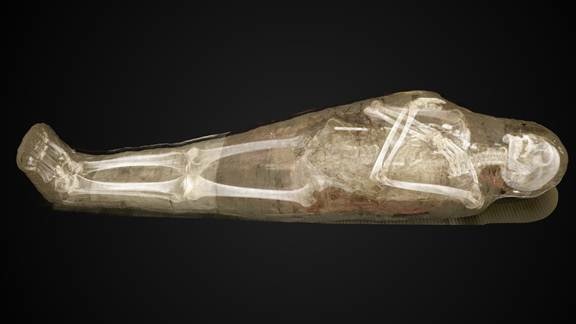The Museum of Mediterranean and Near Eastern Antiquities (Medelhavsmuseet) in Stockholm, Sweden is pioneering an entirely new way for visitors to interact with a collection of six ancient mummies. Instead of staring into glass cases to see only the surface of each mummy, what if visitors could operate a large touch-screen, digital “table” display allowing them to rotate 3D images and explore the inside secrets each mummy holds? That’s the goal behind a remarkable digital reality capture project that kicked off this month and will lead to a ground breaking, interactive permanent exhibit slated to open in February of 2014.
 Early visualization of CT scan – forensic experts scanned each mummy using state-of-the-art dual energy Computer Tomography (CT)A dream team of experts has been assembled to tackle the challenge of making the Museum’s vision of an interactive 3D exhibit a reality. Contributors include representatives from the Interactive Institute Swedish ICT, Norrköping Visualization Center C, the Center for Medical Imaging and Visualization (CMIV), the Museum of Mediterranean and Near Eastern Antiquities, FARO (maker of advanced computer-aided measurement and imaging devices and software) and Autodesk’s Tatjana Dzambazova, senior product manager in the Reality Capture group.
Early visualization of CT scan – forensic experts scanned each mummy using state-of-the-art dual energy Computer Tomography (CT)A dream team of experts has been assembled to tackle the challenge of making the Museum’s vision of an interactive 3D exhibit a reality. Contributors include representatives from the Interactive Institute Swedish ICT, Norrköping Visualization Center C, the Center for Medical Imaging and Visualization (CMIV), the Museum of Mediterranean and Near Eastern Antiquities, FARO (maker of advanced computer-aided measurement and imaging devices and software) and Autodesk’s Tatjana Dzambazova, senior product manager in the Reality Capture group.
The team has already achieved several milestones in just two weeks of work this month. The first step involved forensic experts scanning each mummy using state-of-the-art dual energy Computer Tomography (CT). The dual energy CT scan not only revealed the interior in very high detail, but it also revealed the type of material from which different objects inside the mummy are made. The dual energy technique enabled these objects to be visualized individually in greater detail than ever before.
Next, Tatjana and colleagues from Interactive Institute Swedish ICT and FARO conducted a surface scan using a combination of photogrammetry and laser scanning to digitally capture the intricate surfaces, colors and textures of the multilayered mummies (the Egyptians would wrap the body in multiple layers of cloth, and often encase the body in multiple coffins, or sarcophagi). Digital photo and laser scan data was then imported into Autodesk ReCap to help create High-quality 3D data.
“Autodesk ReCap software simplifies the process of documentation by creating contextual 3D digital data of physical objects and environments with laser scans and photos,” said Tatjana. “This mummy exhibition is a new exciting application of reality capture technology because it demands incredible quality to deliver interactive, highly appealing visual content to engage visitors.”
With the initial reality capture phase complete, the next phase of the project will be to bring all of the interior and surface data together to provide the foundation for the innovative real-time digital, interactive table display experience to be developed by the Interactive Institute Swedish ICT.
For More Information